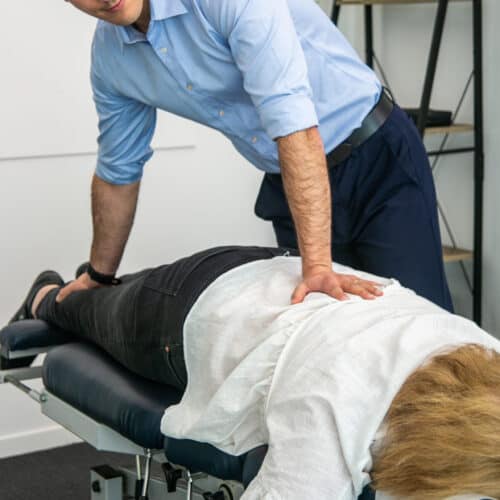Chronic lower back pain remains one of the leading causes of disability globally, with up to 80% of people experiencing lower back pain at some point during their lifetime1. In recent decades there has been an exponential increase in medications, injections and surgery in the management of lower back pain2. This has been an attempt to target underlying spinal structures, however, recent evidence has shown that only 8-15% of lower back pain is due to a specific underlying cause.
Chronic Low Back Pain | Geelong chiropractor
The signs and symptoms our Geelong chiropractor might see:
- Prolonged pain and stiffness (lasting 2-3 months or more)
- Persists beyond expected healing time frame
- Impaired mobility
- Avoidance of activities
- Often no well-defined underlying cause
- Radicular or non-radicular pain referral
Strategies our Geelong chiropractor may use for chronic low back pain:
- Manual therapy (E.g adjustments, soft tissue therapy)
- Gradual exercise therapy and rehabilitation
- Guidance on activity modification
- Education on better self-management
Chiropractic care is focused on reducing pain, restoring movement and regaining function of the spine. Getting you back to the important things in life.

Lumbar Facet Injury
Lumbar facet injuries can occur with repetitive extension or loading of the spine, where the posterior joints of the spine, the facet joints, are susceptible to injury and irritation.
Signs and symptoms our Geelong chiropractors may see:
- Pain and symptoms more local to the lower back
- Pain relief with hip and spinal flexed positions
- Often no leg symptom referral
Chiropractic care and management may include spinal manipulative techniques, soft tissue therapies, exercise and rehabilitation, along with lifestyle guidance. Chiropractic care is focused on reducing inflammation within the joint, improving movement and function to prevent future irritation.
Spinal Stenosis
Spinal stenosis is described as the narrowing of the spinal canal, most notably in the lower back and neck regions. The narrowing of the canal can put pressure on the nerves as they travel through the spine. Some people with spinal stenosis may not experience symptoms. These structural narrowing are often attributed to age-related changes.
Some symptoms and signs we may see include:
- Symptoms involved in both legs
- Leg pain often worse than back pain
- Pain increases with activity (i.e. standing, walking)
- Pain relief with rest (i.e. sitting)
Chiropractic care and management may include techniques aimed at increasing canal size, soft tissue therapies, exercise and rehabilitation, along with lifestyle guidance. Chiropractic care is focused on pain relief, while promoting better function and movement through the spine.
References
- Annemarie de Zoete, Sidney M. Rubinstein, Michiel R. de Boer, Raymond Ostelo, Martin Underwood, Jill A. Hayden, Laurien M. Buffart, Maurits W. van Tulder, G. Bronfort, N.E. Foster, C.G. Maher, J. Hartvigsen, P. Balthazard, F. Cecchi, M.L. Ferreira, M.R. Gudavalli, M. Haas, B. Hidalgo, M.A. Hondras, C.Y. Hsieh, K. Learman, P.W. McCarthy, T. Petersen, E. Rasmussen-Barr, E. Skillgate, Y. Verma, L. Vismara, B.F. Walker, T. Xia, N. Zaproudina, The effect of spinal manipulative therapy on pain relief and function in patients with chronic low back pain: an individual participant data meta-analysis, Physiotherapy, Volume 112, 2021, Pages 121-134, ISSN 0031 9406, https://doi.org/10.1016/j.physio.2021.03.006.
- Bryan M. Bond, Chris D. Kinslow, Adam W. Yoder & Wen Liu (2020) Effect of spinal manipulative therapy on mechanical pain sensitivity in patients with chronic nonspecific low back pain: a pilot randomized, controlled trial, Journal of Manual & Manipulative Therapy, 28:1, 15-27, DOI: 10.1080/10669817.2019.1572986


